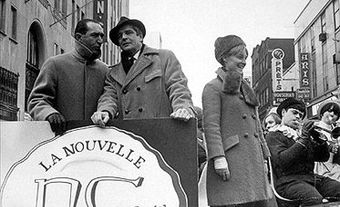Rainbow Stage
When the old bandstand in Kildonan Park, north Winnipeg, was damaged in the 1950 flood, the idea of replacing it with a structure suitable for use as an open-air theatre took hold in the city. Thomas R. Hodgson, superintendent of parks, and James Duncan, director of the University of Manitoba Glee Club, were early advocates of the idea, which was inspired by Vancouver's Theatre Under the Stars.Rainbow Stage, named for its rainbow-shaped proscenium arch, opened with a variety show directed by Duncan on 7 July 1954. In September 1955 Duncan directed the first musical comedy performed there, Brigadoon, which marked the beginning of a tradition. Thereafter MUSICAL THEATRE became the staple of the theatre's summer seasons. Director John HIRSCH, choreographer Arnold SPOHR and actress Evelyn Anderson were among the early participants in Rainbow Stage productions.
Early Years
In the early 1960s the theatre became increasingly professional, but encountered financial difficulties. In 1964 New York producer Michael McAloney was hired to run the theatre. His attempts to attract audiences with a four-musical summer season featuring faded American stars proved disastrous. At the end of the 1965 season the company folded with debts of $95 000.
New Incarnation
A year later a new company was created to operate the theatre and Jack Shapira was hired as producer. Shapira ran the theatre for the next 22 years, presenting two shows each summer - usually popular Broadway musicals from the 1940s and '50s - and producing them semi-professionally, with smaller parts and chorus played by local amateurs. Shapira rarely ran a deficit and audiences were often above 90% of capacity. A geodesic dome roof was built over the seating area in 1970. It was during the period of Shapira's direction that attendance at Rainbow Stage became a summer ritual for many Winnipeg families and participation in the chorus the first step up the show-business ladder for many young performers.
Loss and Scandal
In 1988 Shapira was convicted of stealing $381 000 from the theatre and sentenced to 18 months in jail. He reimbursed the theatre, and much of the money collected from him was returned to the theatre's funders. A substantial portion of the rest was lost on a disastrous production of Anne of Green Gables (the only Canadian work ever produced by the theatre), which was presented at the Pantages Playhouse Theatre in an experimental winter season that unfortunately coincided with the height of the scandal.
Shapira's successor, Jack Timlock, faced disillusioned audiences, cuts in goverment grants and increased production expenses. His attempts to make the productions more professional and to present works such as Sweet Charity and A Funny Thing Happened on the Way to the Forum (not family-orientated) only aggravated the financial problems. Timlock resigned after the 1992 season, and in 1993 the company again folded.
Another Incarnation
Some of the same businessmen who had rescued the theatre in 1966 did so again. They set up a new company and continued to operate the theatre. This new incarnation of Rainbow Stage opened in 1993 with Fiddler on the Roof (for the fourth time). With a conservative policy of offering only one carefully chosen musical per summer, the organization gradually re-established itself. In 2000 it began presenting productions during the winter, and several, including Footloose (2003) and Chicago (2004), were very successful.
Staying in the Black
The precariousness of the company's finances, which rely almost entirely on the box office, was demonstrated again in 2005. Ending its 50th anniversary season with a surplus of $500 000, it saw 2 expensive winter shows lose money and its summer production of the 1920s musical Good News flop badly, while there was yet another loss on Smokey Joe's Café the following fall, leaving the company almost bankrupt. A successful fundraising campaign and a well-attended summer production of The Wizard of Oz in 2006 brought Rainbow Stage once again back from the brink.
Lately
Under the leadership of executive producer Ken Peter, in 2010 Rainbow Stage returned to its roots as a summer-only theatre with a 2-show season. For the first show the theatre is transformed from 2200 to a more intimate 780 seats for adult-themed musicals; the second show is a large family-friendly production. Small-theatre shows have included Rent (2010), Cats (2011) and Footloose (2012).
A new leadership structure brought Julie Eccles (general manager since 2010) to the office of executive director in Nov 2012 and named Ray Hogg the first artistic director the following month.
Rainbow Stage Knew Them When
Well-known performers who gained early experience at Rainbow include Len CARIOU, Heath LAMBERTS, Catherine MCKINNON, Dinah Christie, Fred PENNER, Loreena MCKENNITT and Jeremy Kushnier. Among the stalwart local performers most identified with the theatre are Cliff Gardner, Stan Lesk and Richard Hurst.

 Share on Facebook
Share on Facebook Share on X
Share on X Share by Email
Share by Email Share on Google Classroom
Share on Google Classroom

